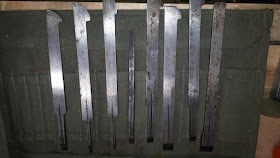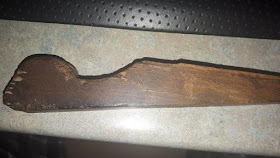Or plow plane in the US.
Here is a tool that doesn't get much love anymore. True, some where rather showy and expensive, often used as presentation piece. But for the usual working man, they may not sport all the bells and whistles, be a tad cankerous to adjust the fence straight and parallel to the body and stay there !
Nonetheless, they are still useful in your modern tool kit. Especially if you ever try to cut a groove with a dado set on a table saw on smaller pieces and would like to keep all your fingers intact.
They are quiet, efficient and yes, do not takes much time to cut your grooves. Because they are set rank. Hint, the cutting end is rather stout.
So lets have a look at common ailments and how to address them.
Disclosure, this blog is the result of a back and forth conversation via Messenger with a friend who just acquired one.
There are wood and metal plow planes, for this entry we will be focusing on the traditional wooden plows.
They originally came with a graduated set of 8 tapered cutters. Most often, they will be found in the wild with either one single blade already installed and the set long separated and MIA, or none at all.
Can we get replacement blades? YES, singles or sets often shows up in tool mongers inventory. Expect to pay about US $100 for a complete match set. Expensive? As with all antique tools, supply is limited and spare parts will cost you more than what you pay for the tool. And if you are lucky you can sometimes spot them in misc. box of hardware at flea markets sales. Often mixed in with chisels and screwdrivers. I always rummage thru those and found the occasional good chisels without a handle for peanuts (pocket changes) And yes the odd plow cutter. Hint look for a groove in the back.
HOWEVER not all irons will fit your plows. First they are tapered. That meant that unless you have the right taper in conjunction with the tapered wedge and the ensemble fit nice and tight in the tool body, we have a problem. You may not be able to chinch the blade down securely or be able to adjust out enough blade to cut. Remember we want to set it up for a rank cut (thick shavings)
Three solutions: 1- Make a new wedge (easier) or 2- Replace the iron. Easiest, if you have another, or
3 - Modify the iron to suit (not recommended).
Another issue, is the centering slot in the back of the iron. These were hand cuts and it shows.
Common issues: The slot is not straight up and down, the slot does not match the plane sole (metal plate on side, call the skate) or is offset enough to cause problems. Iron should fit the skate and be centered
More often than not the slot is too narrow to fit on the sole plate. That last part is crucial to ensure a good solid fit that will not be deflected in use. I repeat, for proper operation the slot must engage the sole piece. That is actually easy to correct, more latter.
If your plane did not came with a set of matching 8 graduated cutters (as they are most often found) you can get by with an Harlequin set. Meaning the set is made up of various makers, which may or may not fit correctly. Don't panic...yet :-)
An easy way to address the centering problem with the iron slot not engaging the skate, is to simply file the skate in a small V shape. CAUTION, go easy, keep it centered by using the same amount of filing on both sides. It DOES NOT NEED to be wide nor coming to a point (sharp) and you DO NOT want to shorten the skate. We just want to taper it down to engage the V slot in the cutter. Stop often to check your progress. The skate does not need to fully seat inside the groove, it just need to register. You can also widen the groove in the back of the cutter with a saw file (triangular) In both case remove just enough to make it register.
Of course its would be easier to remove the skate first, but caution, the screws may be really rusted in place and they may snap on you. A bad thing :-( Shoot them with a penetrant liquid, let it sit for a while, scratch the slots clean and make sure to use a proper fit in screwdriver. If it does not budge STOP leave it alone and regroup.
Other issues to look at are the body. Is it flat or curved? It must be flat. Similar for the metal sole plate (skate) and the fence. Note that the body sides are not too critical, they can have a small hump or hollow, but we want to spot the bowed ones.
How is the fence adjusted and locked in place? There are no shortage of patented ideas to solve the vexing problem of getting the fence to move straight with out skewing and to lock it down once set.
Once unlocked, the fence should move smoothly without much wobble. Often times, the arm get lodged solidly inside the plane body since they are a tight fit to start with in a bid to minimized the play. Years and years of improper storage and the wood swell and shrink causing it to jam.
My Okines had its arms pretty well stuck for years, managed to take it out yesterday. Its been acclimated to my shop for years by now and I run a dehumidifier near my plane till in the summer.
Next take a look at the arms that hold the fence. Often times they are wobbly and can twist.
Must make them secured. But I will caution you about wanting to glue down the arms to the fence.
I never seen them glued, just secured by either a rivet or a screw. You want them tight, but guessing without being glued down and secured via a single fastener allows them to flex a bit as needed without cracking as the body and arms swell and shrink. You also have a cross grain situation if gluing.
How do you adjust it without being skewed? Simply place a piece of wood or what have you of the correct width against the plane body and snug up the fence to it. Easy Peasy. I usually used a piece of wood since it very easy to trim to the correct width.
Then there is the often damaged means of locking the fence down.
Damaged thread on spindle and or wood nuts, missing or improper replacement wedges
(as in the G Davis above) etc,
There is not much we can do about damaged threads, but as long as the nut can move in and out without binding, we should be good.
Next looks at the locking nuts.
If left alone nut would had cracked apart and probably would had been long discarded, rendering the plane useless. If you want to try this type of repair caution do not force whatever material too tight, you run the risk of making it worse, or break it apart. Smaller checked cracks can be secured with glue, either crazy glue or epoxy depending on crack width, but be careful not to get glues on the threads and take the nut out first, you do not want to glue it to the arms.
Missing wedge or wrong replacement. You are going to have to make a new one. Don't sweat it, its not that complicated. If you want to be period correct for the plane, take a look at the original finial at the end of the wedge, or if too damaged or missing, simply look it up on line, chances are you will find pictures of your plane. The wedge shape at the end often helps denote a particular maker and period.
The actual angle of the wedge are typically between 5ish and 7 degrees ( in my humble experiments). But remember that the wedge AND the blade make up the final taper.
Armed with this knowledge, make a graduated set of taper shaped in thin plywood . Says something like 5.5, 6. 6.5, 7 degrees, that would help you get the angle of the tapered mortise. But remember that space is occupied by BOTH the wedge AND the blade.
Another way to guesstimate it close, is to shove in a wad of aluminum foil. Carefully remove and you get the shape. That is what I use to figured out the taper of socket chisels. And writing this I think I`m overdue to make myself a set of graduated templates. I have a few planes in the cue awaiting new wedges :-)
Be prepared to make a few adjustments, but remember to keep the surfaces straight and level. On moulding planes you have to sometimes account for a titled mortise, but on the Plows, these are rather straight forward (pun intended). If you never tried making wedges, try on a Plow first, lot simpler.
The other critical part of the wedge is at the end. When shaped correctly it help curve out and expel the shavings on the side. Look at the pics above by the angle levels, they are all shaped different. Since it is sitting much higher than say a molding plane, it would not be too fuzzy and trap shavings under.
These 3 following pictures are the wedge from the G.Davis plane. It was originally broken in two, long ago, someone attempt a repair by nailing it back together and using hide glue...and made a mess. Not sure about the wood species, but it is rather hard and brittle. The end is polished to a glassy shine.
So when I got it, I try to excavated most of the nail, but I had to leave a piece of it. I made sure nothing interfered and glue the pieces back (3 and a bit) with epoxy. Its working fine. I retained the original.
Once you have assessed its condition, look up the maker's marks on it and do some research to get some idea of its rarity or not, BEFORE attempting any corrective actions. If its a common one (Auburn and Greenfield models shown), I will not hesitate to do some more drastic repairs. Some are really, worth a lot of money, I would then temper my enthusiasm for repairs and preserved as much as I can. Even if that mean, I cannot fix it without... Lots of plow planes were presentation pieces. Congrats you just made your own :-)
Good news is next time you will know what to look for before purchasing and know how to address common issues.












































